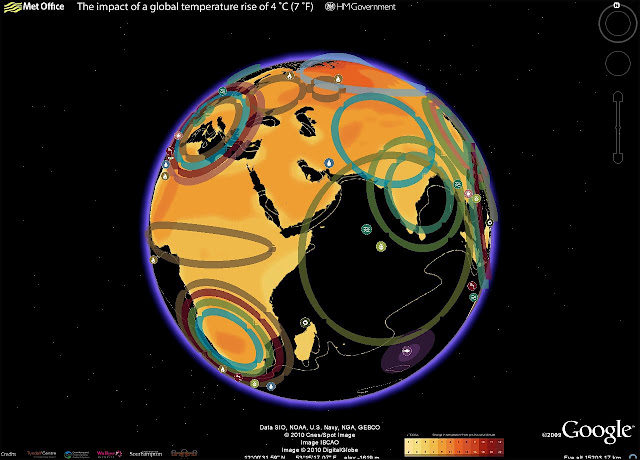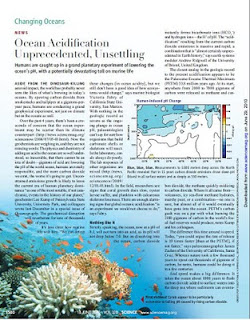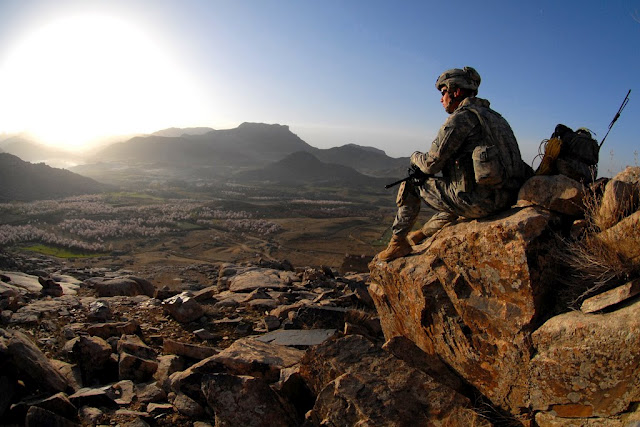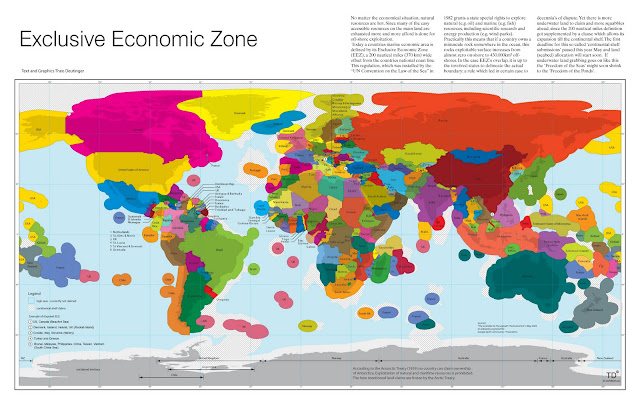-
U.S. v. China: The Global Battle for Hearts, Minds, and Resources
›September 22, 2010 // By Schuyler NullThis summer, Secretary Clinton gave a speech at the Association of Southeast Asian Nations (ASEAN) summit in Hanoi that Chinese Foreign Minister Yang Jiechi called “in effect an attack on China.” What did Clinton say that prompted such a direct response? She called for negotiations over the rights to resource extraction in the South China Sea to be multilateral rather than bilateral:
-
Rear Admiral Morisetti Launches the UK’s “4 Degree Map” on Google Earth
›Having had such success with the original “4 Degree Map” that the United Kingdom launched last October, my colleagues in the UK Foreign and Commonwealth Office have been working on a Google Earth version, which users can now download from the Foreign Office website.
This interactive map shows some of the possible impacts of a global temperature rise of 4 degrees Celsius (7° F). It underlines why the UK government and other countries believe we must keep global warming to below 2 degrees Celsius, compared to pre-industrial times; beyond that, the impacts will be increasingly disruptive to our global prosperity and security.
In my role as the UK’s Climate and Energy Security Envoy I have spoken to many colleagues in the international defense and security community about the threat climate change poses to our security. We need to understand how the impacts, as described in this map, will interact with other drivers of instability and global trends. Once we have this understanding we can then plan what needs to be done to mitigate the risks.
The map includes videos from the contributing scientists, who are led by the Met Office Hadley Centre. For example, if you click on the impact icon showing an increase in extreme weather events in the Gulf of Mexico region, up pops a video clip of the contributing scientist Dr Joanne Camp, talking about her research. It also includes examples of what the UK Foreign and Commonwealth Office and British Council are doing to increase people’s awareness of the risks climate change poses to our national security and prosperity, thus illustrating the FCO’s ongoing work on climate change and the low-carbon transition.
Rear Admiral Neil Morisetti is the United Kingdom’s Climate and Energy Security Envoy. -
Rough Waters Ahead: Our Changing Ocean
›From the ocean-themed June issue of Science comes “Sea-Level Rise and Its Impact on Coastal Zones“, by Robert J. Nicholls and Anny Cazenave. While sea-level rise will “almost certainly accelerate through the 21st century and beyond because of global warming,” Nicholls and Cazenave state that its magnitude remains uncertain. Small islands as well as the coasts of Africa, India, Southeast Asia, and China are identified as vulnerable areas because of their “dense populations, low elevations, appreciable rates of subsidence, and/or inadequate adaptive capacity.” Nicholls and Cazenave call for more research and analysis into adaptation, which “remains a major uncertainty.” “Ocean Acidification: Unprecedented, Unsettling,” by Richard A. Kerr, also appears in the June issue of Science. “Humans are caught up in a grand planetary experiment of lowering the ocean’s pH, with a potentially devastating toll on marine life,” begins Kerr, who aims to convince climate change-focused readers to also look at the world’s oceans. Rising pH levels, caused by ocean waters absorbing higher levels of carbon dioxide, are damaging shelled creatures, coral, and the organisms that rely on them for sustenance (which includes people, especially coastal populations dependent on the oceans for protein). An Australian survey recently found that calcification in the Great Barrier Reef had declined 14.2 percent since 1990 – a severe decline that has not been matched in the last 400 years. Kerr claims that “aside from the dinosaur-killing asteroid impact, the world has probably never seen the likes of what’s brewing in today’s oceans.”
“Ocean Acidification: Unprecedented, Unsettling,” by Richard A. Kerr, also appears in the June issue of Science. “Humans are caught up in a grand planetary experiment of lowering the ocean’s pH, with a potentially devastating toll on marine life,” begins Kerr, who aims to convince climate change-focused readers to also look at the world’s oceans. Rising pH levels, caused by ocean waters absorbing higher levels of carbon dioxide, are damaging shelled creatures, coral, and the organisms that rely on them for sustenance (which includes people, especially coastal populations dependent on the oceans for protein). An Australian survey recently found that calcification in the Great Barrier Reef had declined 14.2 percent since 1990 – a severe decline that has not been matched in the last 400 years. Kerr claims that “aside from the dinosaur-killing asteroid impact, the world has probably never seen the likes of what’s brewing in today’s oceans.” -
U.S. Navy Task Force on Implications of Climate Change
›What about climate change will impact us? That’s the question the Navy’s Task Force Climate Change is trying to answer. Rear Admiral David Titley explains the task force’s objectives in this interview by the American Geophysical Union (AGU) at their recent “Climate Change and National Security” event on the Hill.
The task force is part of the military’s recent efforts to try to better understand what climate change will mean for the armed forces, from rising sea levels and ocean acidification to changing precipitation patterns. In the interview, Admiral Titley points out that for the Navy in particular, it is important to understand and anticipate what changes may occur since so many affect the maritime environment.
The Navy’s biggest near-term concern is the Arctic, where Admiral Titley says they expect to face significant periods of almost completely open ocean during the next two to three decades. “That has huge implications,” says Titley, “since as we all know the Arctic is in fact an ocean and we are the United States Navy. So that will be an ocean that we will be called upon to be present in that right now we’re not.”
Longer term, the admiral points to resource scarcity and access issues and sea level rise (potentially 1-2 meters) as the most important contributing factors to instability, particularly in places like Asia, where even small changes can have huge impacts on the stability of certain countries. The sum of these parts plus population growth, an intersection we examine here at The New Security Beat, is something that deserves more attention, according to Titley. “The combination of climate, water, demographics, natural resources – the interplay of all those – I think needs to be looked at,” he says.
Check out the AGU site for more information, including an interview with Jeffrey Mazo – whose book Climate Conflict we recently reviewed – discussing climate change winners and losers and the developing world (hint: the developing world are the losers).
Sources: American Geophysical Union, New York Times.
Video Credit: “What does Climate Change mean for the US Navy?” courtesy of YouTube user AGUvideos. -
Trillions of Dollars of Minerals? Misusing Geology and Economics to the Detriment of Policy
›Monday’s New York Times article, “U.S. Identifies Vast Mineral Riches in Afghanistan,” triggered a memory of a 70s-era Popular Science magazine cover that screamed “$3 trillion of minerals on the ocean floor!” That article, along with speeches from promoters of deep seabed mining, built up the anticipation that there were windfall profits to be had from the deep seabed. From this gross misuse of geologic speculation came all the difficulties with the negotiations of Part XI of the Law of the Sea Convention — and the United States’ continuing struggle to join the convention.
One of my roles on the U.S. delegation to the Law of the Sea Conference in 1979 and 1980 was to play defense against the misuse of geology and mineral economics in the negotiations, both by countries on the other side of the negotiating table and by seabed mining promoters at home. Part of that task was to gather and accurately “translate” the scientific and economic data from mineral statistics agencies, including the U.S. Bureau of Mines (since incorporated into the U.S. Geological Survey [USGS]), for policymakers and diplomats.
At times I felt like a goalie in the Part XI negotiations, blocking shots being taken by the forwards of the other teams that were promoting seabed mining as an economic bonanza. Unfortunately, by that time, too many groups had a vested interest in portraying the profitability of deep seabed mining and we couldn’t (yet) turn back the clock to a more reasonable approach.
When I read this week’s article in The New York Times, I had the same feeling of policy being manipulated by misuse of geologic data. With some help, I located the original DOD powerpoint presentation. The differences illustrate how science and economics can be misused to cause extensive damage in the policy process—a lesson I learned from the Law of the Sea negotiations.
The New York Times left out two important items from the DOD graphic accompanying the article:
First, the word “undiscovered” was left out; the original phrase reads “known and estimated ‘undiscovered’ resources anticipated by USGS and AGS and using prices as of 12/09.” Not only does that hide the important fact that the resources cited have not yet been discovered, it obscures that the estimates are largely defined by the USGS as either “hypothetical” and “speculative” resources — not the kind of numbers on which to stake a strategy for war and peace.
Second, the article omitted a caveat from DOD’s original powerpoint slide: “USGS agrees with the assertion: ‘At least 70 percent of Afghanistan’s mineral resources are yet to be identified.’”
Therefore, less than 30 percent of DOD’s estimated value is based on tangible evidence of deposits and 70 percent of the estimate is based on hypothetical or speculative resources of uncertain grade and abundance.
The value depends not just on metal content but also on the type of mineral, the grade (percent metal content) in the deposit, the size of the deposit, the distance from fuel and power, the amount of earth that covers the deposit, among other factors. If this report had geological merit as a USGS report, it would have said how much ore was in place at what grade.
Assigning a value to as yet undiscovered deposits is an effective way to influence a policymaker in a powerpoint presentation or generate a headline story from a reporter who has no experience with the terms of art used by geologists. But it has little to do with reality.
So, I drafted these points in response to the story in The New York Times:- According to the USGS, at least 70 percent of Afghanistan’s mineral wealth as estimated by the DOD is hypothetical or speculative, based on geologic theories, not measurement.
- The value estimates are grossly exaggerated by including sub-economic resources because they fail to consider capital and operating costs of recovery and processing to recover ore and convert it to finished metal.
- The DOD assessment fails to note whether the known or hypothetical deposits in Afghanistan are capable of competing economically with known and hypothetical deposits elsewhere in the world.
- Seventy-six percent of the estimated value comes from iron and copper, both of which are already found and produced in many locations around the world in commercially viable mines.
- The DOD values fail to distinguish between economically viable deposits and those that cannot be profitable in the foreseeable future, or to note those that are entirely speculative.
- The headline value of nearly $1 trillion is grossly in error and misinforms policymakers as to the economic potential of mineral deposits in Afghanistan.
Caitlyn L. Antrim is the executive director of the Rule of Law Committee for the Oceans. This article originally appeared in The Ocean Law Daily. To subscribe, please email caitlyn@oceanlaw.org.
Read more on Afghanistan’s mineral wealth and transparency initiatives on The New Security Beat.
Photo Credit: “Sunrise in Afghanistan,” courtesy of flickr user The U.S. Army. -
Natural Resource Frontiers at Sea
›As burgeoning populations and growing economies strain natural resource stocks around the world, countries have begun looking to more remote and difficult-to-access resources, including deep-sea oil, gas, and minerals. The UN Convention on the Law of the Sea (UNCLOS) guarantees exclusive access to these resources within 200 nautical miles of a nation’s sovereign territory – called an exclusive economic zone (EEZ). TD Architects’ “Exclusive Economic Zone” illustrates this invisible global chessboard and highlights some examples of disputed areas, such as the South China Sea, the Mediterranean, the Falkland/Malvina Islands, and the Arctic.
-
Deepwater Horizon Prompts DOD Relief Efforts, Questions About Energy Security
›May 6, 2010 // By Schuyler NullAs the crippled Deepwater Horizon oil rig continues to spew an estimated 210,000 gallons of crude oil a day into the Gulf of Mexico, the Department of Defense has been asked to bring its considerable resources to bear on what has become an increasingly more common mission – disaster relief.
British Petroleum has requested specialized military imaging software and remote operating systems that are unavailable on the commercial market in order to help track and contain the spill.
In addition, the Coast Guard has been coordinating efforts to burn off oil collecting on the ocean’s surface and thousands of National Guard units have been ordered to the Gulf coast to help erect barriers in a bid to halt what President Obama called “a massive and potentially unprecedented environmental disaster,” as the oil slick creeps towards the coast.
As shown by these calls and the ongoing earthquake relief effort in Haiti, the military’s ability to respond to large-scale, catastrophic natural (and manmade) disasters is currently considered unmatched. The first Air National Guard aircraft was on the ground in Haiti 23 hours after the earthquake first struck, and DOD’s Transportation Command was able to begin supporting USAID relief efforts almost immediately. The Department of Defense also spearheaded American relief efforts after the 2004 tsunami and played a critical role in providing aid and security in New Orleans after Hurricane Katrina.
The Pentagon’s four-year strategic doctrine, the Quadrennial Defense Review (QDR), released earlier this year, predicts that such humanitarian missions will become a more common occurrence for America’s military, as the world grapples with the destabilizing effects of climate change, population growth, and competition over finite energy resources. Some experts see this expansion of the military’s portfolio as an essential part of a “hearts and minds” strategy, while others are critical of the military’s ability to navigate the difficulties of long-term reconstruction.
The QDR also highlights DOD’s efforts to reduce the need for oil – and thus deepwater oil rigs – in the first place.
The DOD as a whole is the largest consumer of energy in the United States, consuming a million gallons of petroleum every three days. In accordance with the QDR, Pentagon leaders have set an ambitious goal of procuring at least 25 percent of the military’s non-tactical energy requirement from renewable sources by 2025. The Air Force – by far the Pentagon’s largest consumer of petroleum – would like to acquire half of its domestic jet fuel requirement from alternative fuels by 2016 and successfully flight-tested a F/A-18 “Green Hornet” on Earth Day, using a blend of camelina oil and jet fuel.
At a speech at Andrews Air Force Base in March, President Obama lauded these efforts as key steps to moving beyond a petroleum-dependant economy. However, at the same event, he announced the expansion of off-shore drilling, in what some saw as a political bone thrown to conservatives. Since the Deepwater Horizon incident, the administration announced a temporary moratorium until the causes of the rig explosion and wellhead collapse have been investigated.
Cleo Paskal, associate fellow for the Energy, Environment, and Development Programme at Chatham House, warns that without paying adequate attention to the potential effects of a changing environment on energy infrastructure projects of the future – like the kind of off-shore drilling proposed for the Gulf and Eastern seaboard – such disasters may occur more frequently.
In an interview with ECSP last fall, Paskal pointed out that off-shore oil and gas platforms in the Gulf of Mexico were a prime example of how a changing environment – such as increased storm frequency and strength – can impact existing infrastructure. “Katrina and Rita destroyed over 400 platforms, as well as refining capacity onshore. That creates a global spike in energy prices apart from having to rebuild the infrastructure.”
The Department of Defense has demonstrated – in policy, with the QDR, and in action – that it can marshal its considerable resources in the service of renewable energy and disaster relief. But given the scope of today’s climate and energy challenges, it will take much more to solve these problems.
Photo Credit: “Deepwater Horizon,” courtesy of flickr user U.S. Coast Guard. U.S. Air Force Tech. Sgt. Joe Torba of the 910th Aircraft Maintenance Squadron, which specializes in aerial spray, prepares to dispatch aircraft to a Gulf staging area. -
Philippines’ Bohol Province: Elin Torell Reports on Integrating Population, Health, and Environment
›For 10 years, I have been working on marine conservation in Tanzania with the University of Rhode Island’s Coastal Resources Center. As part of that effort, I’ve helped forge links between HIV/AIDS prevention in vulnerable fishing communities and marine conservation. However, family planning and reproductive health (FP/RH) were relatively new to me. But a recent study tour of an integrated Population, Health, and Environment (PHE) program in the Philippines helped me understand that combining family planning services and marine conservation can help reduce overfishing and improve food security.
Together with developing country representatives from seven African and Asian countries, I spent two weeks in February visiting three PHE learning sites and a marine protected area in Bohol province in the central Philippines, as part of a South-to-South study tour sponsored by the USAID-funded BALANCED Project, for which I work. The tour focused on the activities of the 10-year-old Integrated Population and Coastal Resource Management Initiative (IPOPCORM) project, which is run by PATH Foundation Philippines, Inc. (PFPI).
IPOPCORM has garnered a wealth of lessons learned and best practices to share with PHE newbies like me. Its integrated programs train people to be community-based distributers (CBDs) of contraceptives and PHE peer educators, as well as work with local and regional government officials to build support for family planning as a means to improve food security.
I was most impressed with the ways in which PFPI identifies and cultivates dynamic and motivated local leaders–men, women, and especially youth–to reach out to the members of their community who are highly dependent on marine resources for their survival. My Tanzanian colleagues and I would like to foster the volunteer spirit and “can do” attitudes we experienced through our work in East Africa. (Similar PHE peer educators are successfully working in Ethiopia’s Bale Mountains, as reported by Cassie Gardener in a previous edition of the “Beat on the Ground.”
My favorite part of the tour was a trip to the Verde Island Passage to see PFPI’s efforts in this fragile hotspot. The insights my Tanzanian colleagues and I gained from talking to the field practitioners in the Verde Islands helped us refine our ideas for translating some of the PHE techniques used in the Philippines to the Tanzanian cultural context, including an action plan for strengthening our existing PHE efforts with CBDs and peer educators.
Thanks to the study tour, I now have a better understanding of how to address population pressures in the context of conservation. Overall, my Tanzanian colleagues and I were inspired by the successes we saw firsthand and hope to emulate them to some degree in our own projects.
Elin Torell is a research associate at the Coastal Resources Center at the University of Rhode Island. She is the manager of CRC’s Tanzania Program and coordinates monitoring, evaluation, and learning within the BALANCED project.
Showing posts from category oceans.












